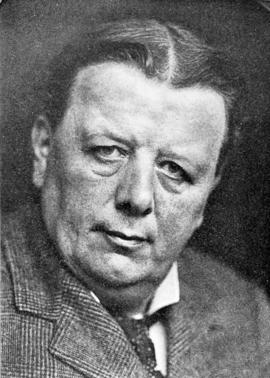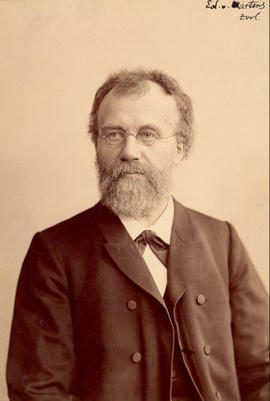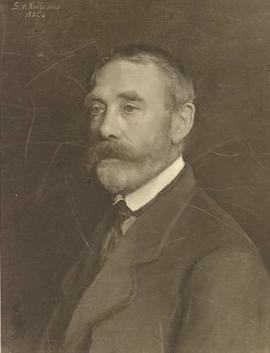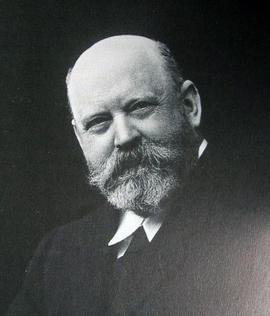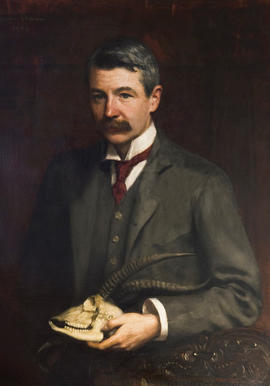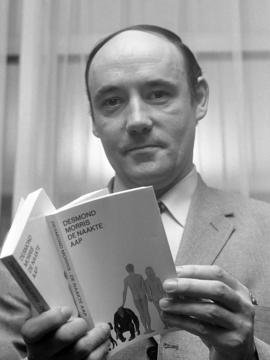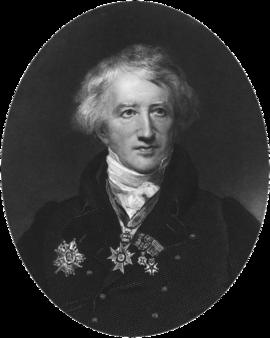Sir Edwin Ray Lankester was an invertebrate zoologist and evolutionary biologist. He held chairs at University College London and Oxford University. He was the third Director of the Natural History Museum, and was awarded the Copley Medal of the Royal Society
Also known as Carl or Karl Eduard von Martens, he was a German zoologist. He attended university in Tübingen, where he graduated in 1855. He then moved to Berlin, where he would be based for the remainder of his career, both at the Zoological Museum of the Berlin University (from 1855) and, from 1859, at the Museum für Naturkunde. In 1860, he embarked on the Thetis expedition of the Prussian expedition to Eastern Asia. When the expedition returned to Europe in 1862, von Martens continued to travel around Maritime Southeast Asia for 15 months. He published the results of the Thetis expedition in two volumes, constituting the Zoologischer Theil of the "Preussische Expedition nach Ost-Asien." Vol. ii, consisting of 447 pages and 22 plates, contained a very full account of the land molluscs. Back in Berlin, von Martens was curator of the malacological and other invertebrate sections until his death. Von Martens described 155 new genera (150 of them molluscs) and almost 1,800 species (including around 1,680 molluscs, 39 crustaceans and 50 echinoderms.
He was a foreign member of the Linnean Society, and a corresponding member of the Zoological Society of London
Wilhelm Engelhard Nathusius (from 1861 Wilhelm von Nathusius-Königsborn) was a wealthy Prussian land owning agriculturalist, industrialist, animal breeder and agronomist who also contributed to studies in zoology, particularly on the eggs of birds. An English translation of his work on eggshells was published by Cyril Tyler in 1964
Lionel Walter Rothschild, 2nd Baron Rothschild, Baron de Rothschild was a British banker, politician, zoologist and soldier. Rothschild studied zoology at Magdalene College, Cambridge. At its largest, Rothschild collection included 300,000 bird skins, 200,000 birds' eggs, 2,250,000 butterflies and 30,000 beetles as well as thousands of specimens of mammals, reptiles and fish. They formed the largest zoological collection ever amassed by a private individual. The Rothschild giraffe, a subspecies with five ossicones instead of two, was named after him. Another 153 insects, 58 birds, 17 mammals, three fish, three spiders, two reptiles, one millipede and one worm also carry his name. Rothschild opened his private museum in 1892. It housed one of the largest natural history collections in the world and was open to the public. In 1932, he was forced to sell the majority of his bird collection to the American Museum of Natural History. In 1933, he was one of eleven people involved in the appeal that led to the foundation of the British Trust for Ornithology, an organisation for the study of birds in the British Isles. On his death in 1937, his museum and all of its contents were given in his will to the British Museum (Natural History). The Walter Rothschild Zoological Museum at Tring is now a division of the Natural History Museum
Thomas worked at the Natural History Museum on mammals, describing about 2,000 new species and subspecies for the first time. He was appointed to the museum secretary's office in 1876, transferring to the zoological department in 1878. In 1891, Thomas married Mary Kane, daughter of Sir Andrew Clark, heiress to a fortune, which gave him the finances to hire mammal collectors and present their specimens to the museum. He also did field work himself in Western Europe and South America. His wife shared his interest in natural history, and accompanied him on collecting trips. In 1896, when William Henry Flower took control of the department, he hired Richard Lydekker to rearrange the exhibitions, allowing Thomas to concentrate on these new specimens
Desmond John Morris is an English zoologist, ethologist and surrealist painter, as well as an author in human sociobiology. He is known for his 1967 book 'The Naked Ape' and for his television programmes such as 'Zoo TIme'.
Morris was born in Purton, Wiltshire, to Marjorie (nee Hunt) and children's fiction author Harry Morris. He was educated at Dauntsey's School, Wiltshire. In 1946 he joined the British Army for two years of national service, becoming a lecturer in fine arts at the Chiseldon Army College in Wiltshire. After being demobilised he studied zoology at the University of Birmingham. In 1951 he began a doctorate at the Department of Zoology, University of Oxford, in animal behaviour. In 1954 he earned a Doctor of Philosophy for his work on the reproductive behaviour of the ten-spined stickleback.
In 1956 he moved to London as Head of the Granada TV and Film Unit for the Zoological Society of London, and studies the picture-making abilities of apes. The work included creating programmes for film and television on animal behaviour and other zoology topics. He hosted Granada TV's weekly 'Zoo Time' programme until 1959, and 'Life in the Animal World' for BBC2. In 1957 he organised an exhibition at the Institute of Contemporary Arts in London, showing paintings and drawings composed by common chimpanzees. In 1958 he co-organised an exhibition, 'The Lost Image', which compared pictures by infants, human adults and apes, at the Royal Festival Hall, London. In 1959 he left 'Zoo Time' to become the Zoological Society of London's Curator of Mammals. In 1964 he delivered the Royal Institution Christmas Lecture on Animal Behaviour. In 1967 he spent a year as Executive Director of the London Institute of Contemporary Arts.
Morris's books include 'The Naked Ape: A Zoologist's Study of the Human Animal' (1967). Morris moved to Malta in 1968 to write a sequel and other books. In 1973 he returned to Oxford to work for the ethologist Niko Tinbergen. From 1973 to 1981, Morris was a Research Fellow at Wolfson College, Oxford. In 1979 he undertook a television series for Thames TV, 'The Human Race', followed in 1982 by 'Man Watching in Japan, The Animals Road Show' in 1986 and then several other series. National Life Stories conducted an oral history interview (C1672/16) with Morris in 2015 for its Science and Religion collection held by the British Library.
In 1906 he obtained his degree from the national veterinary school at Lyon, afterwards attaining a bachelor's degree in natural sciences in 1912, and a doctorate of sciences with a thesis involving plant physiology in 1920. During his career he worked in a military veterinary research laboratory and conducted studies as a microbiologist and immunologist at the Pasteur Institute. In 1931 he resigned from military service, and in 1934 was appointed director of the Vincennes Zoo in Paris. From 1942-1949, he was director of the Museum National d'Histoire Naturelle. In 1937 he scientifically described the kouprey, based on a young male captured in Preah Vihear Province, Cambodia
Hedley was a British zoologist. He was born in 1928 to Henry Armstrong Hedley and Margaret Hopper. He was educated at Durham Johnston School, followed by King's College at Durham University (now Newcastle University) where he obtained a Bachelor's degree in Zoology and a PhD in 1953.
He was first employed at the Natural History Museum in 1955. In 1971 he was appointed Deputy Director of the museum and in 1976 became Director of the museum. In 1988 he retired from the Natural History Museum.
From 1977 to 1980, Hedley was the Honorary Secretary of the Zoological Society of London.
Hedley married Valmai Mary Griffith in 1957 and they had one son. He died aged 77 on 11th July 2006.
Laws was born in Whitley Bay, Northumberland and educated at Dame Allan's School, Newcastle upon Tyne, and St Catharine's College, Cambridge, where he was an Open Scholar.
He started his career as a zoologist on the Falkland Islands Dependencies Survey in 1947, where he investigated the ecology of elephant seals in the South Orkney Islands and South Georgia. These formed the subject of his 1953 Cambridge PhD. After spending a season as a whaling inspector, he joined the National Institute of Oceanography 1955-1961 where he studies great whales and elephant seals.
Outside Antartica, he was also an expert on large African mammals. In 1960 he was appointed Director of the Nuffield Unit of Tropical Animal Ecology in Uganda. Over the next eight years his research focused on hippopotamus and elephant ecology. He spent a year as Director of the Tsavo Research Project in Kenya 1967-1968.
He returned to Cambridge in 1968 to resume his Antarctic research. In 1969 he became Head of the Life Sciences Division of the British Antarctic Survey. He became Director in 1973, a post he held until retirement in May 1987. He was Secretary of the Zoological Society of London 1984-1988. He was Master of St Edmund's College, Cambridge 1985-1996, and he was a member of the Scientific Committee of the International Whaling Commission.
In 1954 Laws won the Bruce Memorial Prize for his work on the ecology of elephant seals. He was awarded the Polar Medal in 1975. He was elected a Fellow of the Royal Society in 1980, and was appointed Commander of the Order of the British Empire. In 1991 he was awarded an Honorary Doctor of Science degree by the University of Bath.
On his retirement, a fund was established for a prize to be awarded in recognition of the achievements of outstanding young scientists of the British Antarctic Survey. The Laws Prize continues to be awarded annually.
A French naturalist and zoologist, sometimes referred to as the 'founding father of palaeontology'. Cuvier was a major figure in natural sciences research in the early 19th century and was instrumental in establishing the fields of comparative anatomy and palaeontology through his work in comparing living animals with fossils
